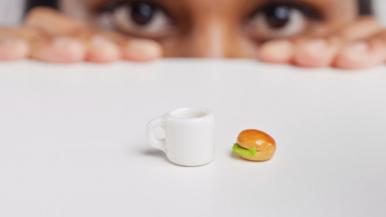Are you having trouble losing weight even though you're making healthier lifestyle choices — sacrificing sweets, swapping French fries for a side salad and sweating bullets at the gym? Do you continue to mount the scale, week after week, only to discover the same stubborn number staring back at you?
The problem might not be what you're eating, but how much you're eating. In fact, portion control is often the most challenging hurdle on a person's path to weight loss.
The skinny on portion size
A study from Cornell University found that the average U.S. adult eats 92 percent of whatever he or she puts on his/her plate. As a general rule, if we see it, we eat it. So most people are more likely to clean their plates than leave food untouched, regardless of what they're eating, or how hungry they really are.
This tendency is particularly problematic when dining out, since restaurant-sized portions typically far exceed the amount of food we actually need.
But even at home, we typically over-serve ourselves and keep food in sight, which tempts us to eat further.
To compound the problem, we also tend to eat while distracted — say, by the TV, our phone, or computer — so that we don't realize we've had enough until we hit the bottom of the chip bag, or our forks come up empty.
Serve veggies and salad family style (placed on the table in a platter) to encourage yourself to take second helpings of high-nutrient, lower-calorie foods.
Rethink your eating habits
The good news is there may be some easy ways to help counter heavy-handed serving habits and unmindful eating. Here are some tips for exercising better portion control:
- Cook high-calorie foods in smaller amounts, so there isn't enough for seconds or thirds.
- Pre-plate the high-calorie foods in the kitchen and leave the serving dishes off the table and out of sight.
- Serve veggies and salad family style (placed on the table in a platter) to encourage yourself to take second helpings of high-nutrient, lower-calorie foods.
- Make dinner an event by using nice dishes and glasses, and keep the television turned off. A more formal setting with fewer distractions may prompt you to pay more attention to what and how much you're eating.
- Use small plates and bowls to help you serve smaller portions.
- Avoid having too many foods on the table. The more variety of flavors you have in front of you, the more you will want to eat.
- Don't clear anything from the table or plate while you're eating. It helps to see empty plates, glasses, etc. to remind yourself how much you've eaten.
These steps take just a tiny bit of extra effort, but they can make a big difference in your awareness of how much you're eating, and help you eat less as a result. They'll also make meals more pleasant, and you'll enjoy eating all the more knowing that you're eating healthfully.




